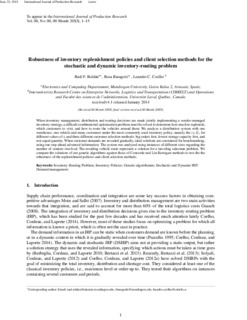Izenburua
Robustness of inventory replenishment and customer selection policies for the dynamic and stochastic inventory-routing problemRobustness of inventory replenishment policies and client selection methods for the stochastic and dynamic inventory-routing problem
Egilea
Argitalpen data
2016Beste erakundeak
Compensar Unipanamericana Institución UniversitariaUniversité Laval
Bertsioa
PostprintaDokumentu-mota
ArtikuluaArtikuluaHizkuntza
IngelesaEskubideak
© 2016 Elsevier Ltd. All rights reserved.Sarbidea
Sarbide irekiaArgitaratzailearen bertsioa
https://doi.org/10.1016/j.cor.2016.04.004Non argitaratua
Computers & Operations Research Vol. 74. Pp. 14–20. October, 2016Argitaratzailea
ElsevierGako-hitzak
Inventory-routing problem
Inventory policies
Customer selection
Dynamic and stochastic IRP ... [+]
Inventory policies
Customer selection
Dynamic and stochastic IRP ... [+]
Inventory-routing problem
Inventory policies
Customer selection
Dynamic and stochastic IRP
Demand management [-]
Inventory policies
Customer selection
Dynamic and stochastic IRP
Demand management [-]
Laburpena
When inventory management, distribution and routing decisions are determined simultaneously, implementing a vendor-managed inventory strategy, a difficult combinatorial optimization problem must be so ... [+]
When inventory management, distribution and routing decisions are determined simultaneously, implementing a vendor-managed inventory strategy, a difficult combinatorial optimization problem must be solved to determine which customers to visit, how much to replenish, and how to route the vehicles around them. This is known as the inventory-routing problem. We analyze a distribution system with one depot, one vehicle and many customers under the most commonly used inventory policy, namely the (s,S), for different values of s. In this paper we propose three different customer selection methods: big orders first, lowest storage first, and equal quantity discount. Each of these policies will select a different subset of customers to be replenished in each period. The selected customers must then be visited by a vehicle in order to deliver a commodity to satisfy the customers' demands. The system was analyzed using public benchmark instances of different sizes regarding the number of customers involved. We compare the quality and the robustness of our algorithms and detailed computational experiments show that our methods can significantly improve upon existing solutions from the literature. [-]
Sponsorship
Canadian Natural Science and Engineering CouncilBildumak
Related items
Showing items related by title, author, creator and subject.
-
Idatzizkoaren hasierako irakaskuntza dispositibo didaktikoen argitan. D ereduko ikastetxe baten kasu azterketa
Egizabal-Ollokiegi, Diego (Mondragon Unibertsitatea. Humanitate eta Hezkuntza Zientzien Fakultatea, 2023)Norberaren garapen osoari egiten dion ekarpenarengatik eta gizarte osoaren garapen eta ongizatearekin konprometitutako hiritar kritiko eta autonomoak sortzeko duen garrantziarengatik (Unesco, 2003, 2006) arduraz begiratzen ... -
Material management without forecasting: From MRP to demand driven MRP
Kortabarria, Alaitz; Apaolaza, Unai; Lizarralde, Aitor; Amorrortu, Itxaso (OmniaScience, 2018)Purpose: Efficient Operations and Supply Chain Management is key to building sustainable competitive edge for companies. However, the achievement of this goal is becoming challenging in the present dynamic production ...





















